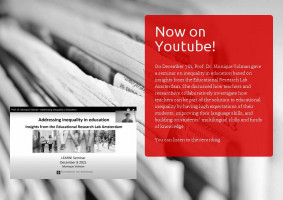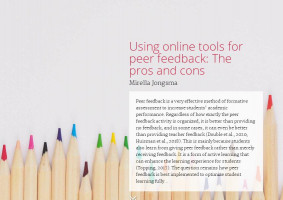Peer feedback is a very effective method of formative assessment to increase students' academic performance. Regardless of how exactly the peer feedback activity is organized, it is better than providing no feedback, and in some cases, it can even be better than providing teacher feedback (Double et al., 2020; Huisman et al., 2018). This is mainly because students also learn from giving peer feedback rather than merely receiving feedback. It is a form of active learning that can enhance the learning experience for students (Topping, 2017). The question remains how peer feedback is best implemented to optimize student learning fully...
Peer feedback is very effective
Peer feedback is a very effective method of formative assessment to increase students' academic performance. Regardless of how exactly the peer feedback activity is organized, it is better than providing no feedback, and in some cases, it can even be better than providing teacher feedback (Double et al., 2020; Huisman et al., 2018). This is mainly because students also learn from giving peer feedback rather than merely receiving feedback. It is a form of active learning that can enhance the learning experience for students (Topping, 2017).
The question remains how peer feedback is best implemented to optimize student learning fully. Nowadays, there are many different ways to implement peer feedback in an academic course. There is the option to offer it as an activity in class, or it could be done online. In the wake of the transition to more blended learning in higher education, teachers often opt for online tools. Is that also the best way to implement peer feedback? What are the advantages of online peer feedback, and are there any disadvantages to consider?
Quite some research has been done to investigate the effects of peer feedback, so it only seems right to summarize the most important pros and cons of online peer feedback.
Pros of online peer feedback
Implementing peer feedback by using an online tool has several advantages. First of all, an online platform specifically designed for providing online (peer) feedback can be an efficient way of organizing a peer feedback activity. It allows the teacher to access all of the feedback comments that
students provide each other and react to them in real-time, rather than having to walk around in class and only be able to catch small parts of what students are saying (DiGiovanni & Nagaswami, 2001). Moreover, a tool makes it easier to opt for an anonymous setting, which can be helpful when students feel pressured by peers to give primarily positive feedback (Lu & Bol, 2007).
"Although there are many advantages to an online peer feedback tool, eventually, the best academic outcomes result from feedback training, clear instructions, and experience with giving feedback."
Although in the best-case scenario, students feel safe enough to provide their peers with honest feedback. Another advantage of online peer feedback is its time independence. Because students can give each other peer feedback in their own time, there is more time for other learning activities in class. On top of that, students may experience more autonomy when they are able to decide for themselves when and how they give peer feedback (Mellati & Khademi, 2014).
Cons of online peer feedback
Although online peer feedback definitely has multiple advantages, it also has its downsides. Perhaps the most important disadvantage of online peer feedback is the loss of a feedback dialogue. When peer feedback is asynchronous, like in most cases when it is offered online, it becomes harder for students to discuss the feedback they give and receive (Guardado & Shi, 2007; Lee & Evans, 2019).
This feedback dialogue is especially important when the feedback is hard to formulate in short comments, such as feedback on behaviour in group projects. A feedback dialogue gives the opportunity to directly react to the feedback that is given and ask for clarification. Moreover, it is easier for students to nuance their feedback when they give it face-to-face rather than when they only have a limited number of words to formulate the feedback. This could, in turn, reduce negative feelings towards peer feedback. However, when a teacher can monitor the feedback comments and students have the ability to rate or react to the feedback they have received, the disadvantage of a lack of feedback dialogue can be reduced significantly (Filius et al., 2018).
In conclusion
The most important thing to remember when implementing peer feedback in your curriculum is that practice makes perfect. Although there are many advantages to an online peer feedback tool, eventually, the best academic outcomes result from feedback training, clear instructions, and experience with giving feedback. The validity and reliability of peer feedback can significantly improve when students receive training in how to give good feedback and are handed feedback aids such as rubrics (Falchikov & Goldfinch, 2000; van Zundert et al., 2010). Considering the advantages and disadvantages of online peer feedback, it eventually is up to the teacher to decide whether offline or online peer feedback is preferred. Online peer feedback might be more effective when the task that is assessed is an essay, whereas offline peer feedback might be better when the feedback has a more subjective nature.























